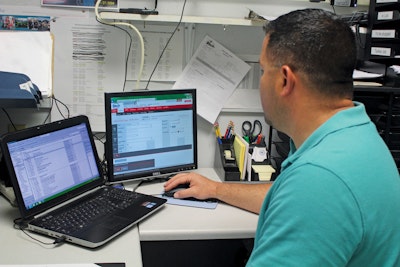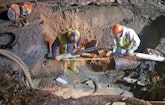
ARCOS is a configurable database that programs lists and call rules for each department, shifting responsibility off the shoulders of dispatchers and supervisors.
Think about the time it takes to put together a crew for emergency work — supervisors poring through pages of employee lists, making call after call, sometimes over an hour or more.
For a long time, that was simply the cost of doing business for both Eugene (Oregon) Water and the Suffolk County (New York) Water Authority, but they found a way to expedite the procedure. In fact, with one piece of technology, it’s now as simple as the press of a button.
ARCOS Callout and Scheduling Suite made that a reality for Eugene and Suffolk by cataloging all work requirements, such as union worker lists and employee availability, and automated their callout procedure for instantaneous crew assignment.
A catalyst
Utilities need a system in place for emergency situations, and the manual processes still used by many municipalities are inefficient and time-consuming.
“Prior to ARCOS, any group that required after-hours callout would provide us a list on paper,” says Larry Longworth, transmission and distribution dispatch supervisor for Eugene Water. “We gathered about 20 different paper lists that would cycle in here either daily, weekly, monthly, or whatever the cycle was for that group.
“So everything was a manual process, everything was a piece of paper, and everything was somebody sitting somewhere manually punching buttons on a phone. And we’d literally take over an hour at times to get a crew complement,” Longworth says. “Nobody was ever happy, the people receiving the calls — there were constant issues with somebody saying ‘I didn’t get called,’ or ‘You didn’t call in the right order,’ or ‘You skipped my number’ — there were always issues with the call receivers who weren’t happy.”
One of the biggest problems is that union employees have certain rules when it comes to the order they are called, due to seniority or hours worked, and having a paper process made things difficult to track.
“Not only did we have a list of names, we had all these rules about how to call those names, and that’s quite often where some of the issues came about,” says Jeff Szabo, CEO of the Suffolk County Water Authority. “Unintentionally, with the old process, there would be errors. A supervisor would misdial, or call somebody on accident, and we would get union grievances from our employees.”
Beyond efficiencies of the system, the major catalyst for Eugene and Suffolk was actually an effort toward employee satisfaction and morale.
“The supervisors hated the old system because when they had to do it, they found out how disjointed the process was,” Longworth says. “It was just years of unhappiness that drove us to look for a solution.”
Many benefits
Failing to toe the line of union rules could result in grievances and subsequent arbitration; time and money lost for the utility.
ARCOS limits the possibility of those mistakes by programming in the lists and call rules for each department.
“It’s a configurable database basically, where you can have one or you can have a hundred different groups in it. You can divide your employees by job title, by any way you want to divide them up, and you can build rosters with callout rules very specific to each group,” Longworth says.
For example, some jobs require a certain ratio of journeymen to apprentices. The ARCOS system keeps track of that and will pass over apprentices in the list until it gets the right percentage of journeymen, and then it will go back to calling apprentices.
There are many benefits, but both Longworth and Szabo say a big perk is shifting responsibility off the shoulders of dispatchers and supervisors. Because the rules are programmed into a concrete automated system, it’s now up to the department head or whatever list-maker to ensure their callout schedule is put into the system correctly.
“It is a bit time-consuming, and you do have to have buy-ins from your roster owners because it does require a different piece of work,” Longworth says. “They’ve been used to sending you a piece of paper and being done with it, and now they have to take a little bit of responsibility and actually learn a piece of software. It was very simplistic to learn, but we did have a little adjustment period trying to get people on board.”
The other major plus of the software is the pure functionality of it; customization is nearly unlimited.
“I would say that’s the power of the tool, the callout functionality, and being able to adjust it and set it any way you want to. It can satisfy anybody’s wishes,” Longworth says.
All this combined allows more efficient time management for the troubleshooters and supervisors who are actually out assessing the emergencies, and simplifies the managerial aspects of emergency work.
“If my supervisors have expertise in managing a water main break or any emergency related to the proper distribution and flow of drinking water, that’s what they should be doing. They should not be spending hours dialing employees’ phone numbers, and we always strive here to provide the best possible customer service,” Szabo says.
Never going back
Both utilities have had the software in place for about a year, and satisfaction is high.
“We don’t worry about who’s on call, who’s the next guy up — we just push the button, and those crews are assembled automatically,” Longworth says. “It was very quick for employees to see the value of it, and I would say at that level everybody loves it now, and it didn’t take very long because it really made their life easier.”
They also don’t have to worry about mistakes and union blowback because they can prove their callout methods with data.
“For the first few months that we implemented, we still had some of the same old questions, about ‘I didn’t get called,’ or ‘I got called out of order,’ but now I could actually do a print-off and show them that yes you did get called, here it is, we can actually hear your interface with the system,” Longworth says. “So another savings is the ability to have that proof, the fact that we don’t have people complain or challenge the callouts anymore, because we have data to support how the callout was done.”
Because it was difficult to collect data with the manual paper system used before, neither utility can really say how much they’ve saved in adopting the program, but they also say that savings are really just icing on the cake.
“Even if we didn’t save end dollars, off what we spent per year in subscription fees, those wouldn’t have to match for the product to be worth it to me. It’s allowing our people to do smarter work,” Longworth says. “Not to say if we really penciled it out, that in the end it wouldn’t justify itself.
“I would never want to go back to the way we used to do it. This is one of the best investments we’ve made as far as I’m concerned.”







